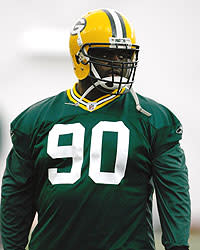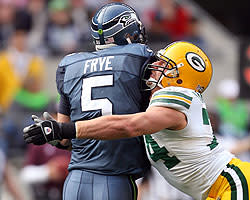Packers in early stages of transition to 3-4
The Green Bay Packers were prepping their counterpunch long before the NFC North arms race began. They started before the Chicago Bears traded for quarterback Jay Cutler(notes), and before the Detroit Lions drafted two first-round offensive pieces (quarterback Matthew Stafford(notes) and tight end Brandon Pettigrew(notes)). Even before the Minnesota Vikings hit the reset button on their flirtation with Brett Favre(notes), and tabbed wide receiver Percy Harvin(notes) in the NFL draft.
Make no mistake, when the coaching staff took its Ginsu knife to the 2008 film, every part of next season's success had to do with last season's most obvious failure.
"The offense wasn't the problem," said Packers linebacker A.J. Hawk(notes). "It was us as a defense. We were giving up too many points, too many rushing yards – everything. It was our fault for going 6-10."

Raji figures to be the Packers' future man in the middle.
(Scott Boehm/Getty)
The offseason transaction wire has said as much, making it rain pink slips on the defensive staff. The canning of five assistants on that side of the ball included defensive coordinator Bob Sanders in what would be a seismic shift to a 3-4 scheme. Dom Capers was tapped as the coordinator to oversee the new look, and by the end of the draft, first-round picks B.J. Raji(notes) and Clay Matthews(notes) would be in the fold at nose tackle and outside linebacker, respectively. Marquee defensive end Aaron Kampman(notes) was moved to outside linebacker, while other talented veterans like Hawk, linebacker Nick Barnett(notes) and cornerback Al Harris(notes) had new challenges thrust upon their skill sets.
This is the Packers' new world order with old world talent. And it has made for interesting drama in the offseason. Kampman, who has had a cadre of teammates and coaches chirping about how he's enjoying his new position, has yet to actually confirm that himself. Indeed, the typically microphone-friendly player hasn't spoken to the media since he was moved out of his position of the last seven seasons following Capers' arrival. He's remained silent despite the team encouraging him to talk, and requests from both local and national reporters.
"I don't want to be redundant – I think this defense is going to help Aaron Kampman," said Packers coach Mike McCarthy, who continued to fight off suggestions last week that Kampman was unhappy with the new scheme. "I think there is always hesitancy when you are asked to do something different.
"Aaron was very comfortable in the old scheme, but I think this is going to create more opportunities for him. There is diversity in the scheme. First and second down is clearly different for him. The sub packages, there is some multiplicity there that I think will also help him. I think he moves well in space. He has spent a lot of individual time with [outside linebackers coach] Kevin Greene. I know Dom Capers and Kevin Greene both feel very good about where Aaron is today, so he's only going to get better."
But as with all moves from 3-4 to the 4-3 alignment, the process of getting better for both Kampman and the Packers is likely to take longer than hoped. Most teams going through the switch typically take one, two or even three years to get all of the proper personnel in place, largely because of the variety of challenges that arise at each position.
Defensive linemen, particularly at end, have to have both size and patience. Pass rushing at the position becomes enigmatic. Linebackers must be versatile enough to thrive in space, be creative and athletic enough to survive in coverage but still maintain the aggression to attack the line of scrimmage as a pass rusher or scrape against the run. Even the secondary faces challenges, particularly cornerbacks (like Harris) who have typically done their best work as physical, man-to-man style players. Now Packers cornerbacks will play less press coverage and more zone, which puts more emphasis on instincts and coverage ability than jamming a wideout off the line of scrimmage.
With that in mind, the change could hurt the aging and likely diminishing athleticism of Harris and cornerback Charles Woodson(notes), but create more playmaking opportunities for Hawk, Barnett and Matthews.
"[The scheme] lets us be aggressive," Hawk said. "It lets us play downhill, and it lets us hopefully go in and try to make some impact plays. All of us as linebackers here, we feel like we're definitely physical players, but we can also play in space. I think this is the best combination of both."
"Anytime you're in the 3-4, the biggest thing you can do is be unpredictable. You can do many different things from many different looks. You can go and attack the offensive line. You get them before they get to you."

Kampman led the Packers with 9½ sacks last season.
(Otto Greule Jr./Getty)
And while the Packers will benefit from having a solidly athletic group to work with during the change, that is likely to have only a marginal impact early on. Long term, 2009 will likely be remembered as a season that exposed the need for even more change. There may already be signs of it. Kampman is heading into the final season of his contract and will turn 30 later this year. It's the same scenario for nose tackle Ryan Pickett(notes), who already has his likely replacement, Raji, on the roster. Both veterans are subject to what is a typical story line in the first year of a move to a 3-4 scheme: They could just as easily be cast off as retained, depending on how they adjust to the system.
"There are some decisions, scheme-specific decisions, when it comes to [the personnel] for a series of years" said an AFC general manager who has knowledge in both the 3-4 and 4-3 defenses. "Some of [the Packers'] finest players, the way the deal works with that change, some of your best players won't fit. Eventually you have to make tough decisions, unpopular decisions. With Capers, they are invested. So in all likelihood some of their best players [from 2009] won't be there after year one or two of the change.
That's just the way it works. It's a progression. Every offseason, it's [asking] 'What's best for this scheme and the team?' "
The latter part of that question – what's best for the Packers – was answered in 2008, when the defense finished in the bottom half of the league in total yards (20th), scoring (23rd), rushing yards (26th) and sacks (25th). It remains to be seen if key parts of the personnel will come through in '09, or if Capers can recreate his magic as a defensive coordinator. But Green Bay is invested, no matter who or what needs to be tweaked from this point forward.
"It's a change that I obviously felt we needed to make," McCarthy said. "It's a change I think I know will give our players the opportunity to be more aggressive. We're playing with more vision. I feel the offense and defense are playing on the same level as far as the mindset of how the game goes. And really, the No. 1 reason I did it, and I told you this before, is because of the personnel. … The 3-4 change has been as much about personnel as it has been about schemes."
